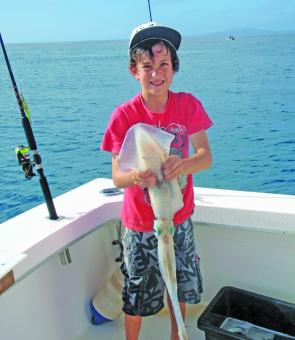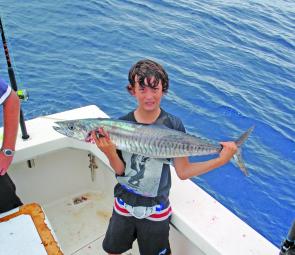The regular rain this year should equate to quality fishing right across our local area. The estuary systems have produced prawns more consistently over a longer period than previous years and the fish inside and just offshore are doing well in the process.
October generally means many of the bigger red fish, like snapper, that have moved into deeper water have started to move back in, so December this year should be out of the ordinary. Some of the better scarlet sea perch were taken just outside the Keppel Bay area and further along the coast.
Following other rain events, the smaller scarlets (nannygai, small and large mouth) flood most of the inner shore reef patches feeding on the abundant prawns.
Spotted mackerel have turned up with the drop in wind at quite a number of locations along the coast. On a recent trip to the shoals we picked up several 10kg+ spotties, something we haven’t seen around here for years.
Cape Capricorn close reefs and the patches heading into the bay have been going well for a while and with each bit of decent conditions the spotted mackerel move in closer. They eventually wind up at the close mack grounds, from Quartz, the islands off Emu Park, Rita Mada, Ironpot, Rosslyn Bay Harbour, Claytons, Stevensons Rocks, Bangalee, Farnborough, Findlays, and Corio Heads. This will give all the little tinnie crew an opportunity for a shot at them over the next month or so.
Most of the time, mackerel will take a lightly weighted floating pilly or a live herring but as a rule a large number of the better spotties landed will jump on a Flasha or similar chromie. Time and again we get spotties among ribbonfish at places like Rita Mada and you can develop little techniques to attract one from the other. Spotties prefer a lure pulled a fraction deeper with the ribbonfish up near the surface above the fish.
Doggies are on tap at the moment whenever the wind drops below 5-10 knots. They can be found at any of the inshore areas with plenty being caught by land-based fishers.
Greys have also made a few appearances of late, particularly at Findlays and Farnborough. And expect a few 10kg+ specimens throughout October.
The areas listed for spotties are all good places to try for any of the lesser mackerel, and even the odd Spanish or cobia following them. There is nearly always the odd Spanish around these waters; it’s normally a resident fish that hangs with the local bait schools instead of travelling with the rest. These fish are usually paler and more slender, like the newly arrived fish as opposed to the heavier, darker, slimier fish fattened up and ready for moving on.
Cobia have begun their latest run in fine form hitting Man & Wife and The Pinnacles in quantity. They can be annoying to the mackerel fishers by slamming baits meant for Spaniards. They love live baits best but floating pillies or iodines make a good backup. They prefer tall structures, but any pinnacle or large bommie should hold cobes when there is a bit of run in the water.
Barra have come on well in the last few weeks, however, we still have a seriously big difference between the amount of keepers caught compared to the number of undersize fish. They have been fairly spread over the length of the saltwater parts of the river and other local systems. The one spot that seems to get a better average fish is Coorooman Creek; funny how there is no legal netting done there. Corio Bay and Army country are other decent barra spots although it takes more effort to get fish as a rule.
This year’s Barra Bounty is on target to be the biggest one yet with Major sponsorship and some fantastic cash and prizes up for grabs. This is strictly a tag a release comp, all fish have to be photographed on a brag mat with the current ID tag in the photo to prevent any possible doubt over the fish capture and then released. All proceeds go to stocking The Fitzroy River.
The barramundi closed season starts at the end of this month at midday 1 November and goes through to 1 February. This gives them a chance to start the next generation of barra.
The Coral Reef Fin Fish Closures are between 5-9 October and the 3-7 November 2010. This allows the reef fishes to spawn in peace, so please leave them alone or risk heavy fines.
Flathead numbers have risen, as expected, as they gathered for breeding. From local reports there were a lot of big females released lately to continue their job. If you do catch a big flatty chances are it will be a breeding female so please put it back, it is much better to take a couple of the smaller males instead.
Whiting have remained in good quantity in the creek mouths and along the beaches from the river mouth heading north. Alhough we don’t get them as big as the southern fish they still get to 350mm, sometimes bigger, and that is quite acceptable. Beach worms and fresh pumped yabbies are the pick baits.
We often drift the mouth of Coorooman Creek on the start of the incoming until we find where the whiting schools are, and then drop the pick. We get smashed up occasionally by the big blue salmon hunting in the same area, but that is to be expected as whiting fillets are among their best baits. The first whiting we catch is usually stripped and the whole fillets are put out the back using a very light sinker and a long trace to a 3/0 suicide and a short stinger 2/0 – if there are any salmon about that will find them.
King salmon seem to be gathering lately, with numbers of them being caught instead of the usual ones and twos. This probably indicates they are in the breeding process, so as a rule we only take a feed. They are feeding actively from Pirates Point up to the Barrage where live prawns and small poddy mullet are the choice baits.
King salmon will take a lure meant for barra at times and definitely go harder for longer so they are a fine sportfish. They tend to work eddies and any of the big structures along the river’s edge are worth a crack. Look for the golf ball size dints in the mud to see where they have been feeding.
The other spots they favour are the just submerged rock bars where you flick a prawn on top and let the current push it over the edge to the waiting salmon.
The islands have been hit with the moving bait schools bringing with them large numbers of trevally. Some of these critters are over 10kg, rounding up and smashing the hardiheads, herrings and gar in water not deep enough for them to swim upright. I came unprepared on their last run as I was expecting 2-3kg fish but got blown away by the giants.
Between the trevors and the queenies on the go at present the islands are worth a visit for the sports fishers.
Reads: 2986
Jay Ferrington with a Keppel squid.

Wayne Thomas with a wide caught wahoo from Yeppoon.

Helen Graham caught this big parrot at Barren.

Jay Ferrington caught this resident Spanish out from Yeppoon.




